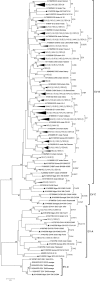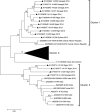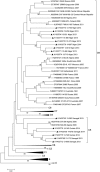Identification and molecular characterization of non-polio enteroviruses from children with acute flaccid paralysis in West Africa, 2013-2014
- PMID: 28630462
- PMCID: PMC5476622
- DOI: 10.1038/s41598-017-03835-1
Identification and molecular characterization of non-polio enteroviruses from children with acute flaccid paralysis in West Africa, 2013-2014
Abstract
Besides polioviruses, non-polio enteroviruses (NPEVs) may also be associated with acute flaccid paralysis (AFP). Because poliomyelitis is on the verge of eradication, more attention should be paid to study NPEVs from non-polio AFP cases and their epidemic patterns. In West African countries the epidemiology of NPEVs remains largely unexplored. We investigated the genetic diversity, frequency, circulation patterns, and molecular epidemiology of NPEVs in seven West African countries by analyzing retrospectively a panel of 3195 stool samples from children with AFP collected through routine poliomyelitis surveillance activities between 2013 and 2014. VP1 sequencing and typing on 201 isolates revealed 39 NPEV types corresponding to EV-A (6.9%), EV-B (90.5%), EV-C (2%) and EV-D (0.5%) species. Echoviruses were isolated most frequently with 138 cases (68.6%), followed by coxsackievirus group B with 35 cases (17.4%). No single NPEV type was remarkably dominant. Interestingly, several rarely described types with limited detection worldwide were identified (EVA76, EVA119, EVB75, EVB77, EVB97, EVC99, CVA20, CVA21 and EVD94). This study demonstrates the extensive diversity and diverse circulation patterns of NPEVs from AFP surveillance and highlights the need to formulate effective long-term strategies to monitor NPEV circulations in West Africa.
Conflict of interest statement
The authors declare that they have no competing interests.
Figures




Similar articles
-
Identification and characterization of nonpolio enterovirus associated with nonpolio-acute flaccid paralysis in polio endemic state of Uttar Pradesh, Northern India.PLoS One. 2019 Jan 30;14(1):e0208902. doi: 10.1371/journal.pone.0208902. eCollection 2019. PLoS One. 2019. PMID: 30699113 Free PMC article.
-
Detection of non-polio enteroviruses from 17 years of virological surveillance of acute flaccid paralysis in the Philippines.J Med Virol. 2012 Apr;84(4):624-31. doi: 10.1002/jmv.23242. J Med Virol. 2012. PMID: 22337302 Free PMC article.
-
Molecular characterization of diverse species enterovirus-B types from children with acute flaccid paralysis and asymptomatic children in Nigeria.Virus Res. 2014 Aug 30;189:189-93. doi: 10.1016/j.virusres.2014.05.029. Epub 2014 Jun 7. Virus Res. 2014. PMID: 24915283
-
[Importance of enteroviruses in neuropaediatrics: from polioviruses to other enteroviruses].Rev Neurol. 2017 May 17;64(s03):S35-S38. Rev Neurol. 2017. PMID: 28524217 Review. Spanish.
-
Wastewater Surveillance in Europe for Non-Polio Enteroviruses and Beyond.Microorganisms. 2023 Oct 5;11(10):2496. doi: 10.3390/microorganisms11102496. Microorganisms. 2023. PMID: 37894154 Free PMC article. Review.
Cited by
-
Detection by Direct Next Generation Sequencing Analysis of Emerging Enterovirus D68 and C109 Strains in an Environmental Sample From Scotland.Front Microbiol. 2018 Aug 21;9:1956. doi: 10.3389/fmicb.2018.01956. eCollection 2018. Front Microbiol. 2018. PMID: 30186268 Free PMC article.
-
Molecular Detection of Enteric Viruses in Under-Five Children with Diarrhea in Debre Tabor, Northwest Ethiopia.Infect Drug Resist. 2022 Apr 20;15:1981-1994. doi: 10.2147/IDR.S364142. eCollection 2022. Infect Drug Resist. 2022. PMID: 35480057 Free PMC article.
-
Molecular epidemiology of enteroviruses associated with hand, foot, and mouth disease in South India from 2015 to 2017.Arch Virol. 2022 Nov;167(11):2229-2238. doi: 10.1007/s00705-022-05561-0. Epub 2022 Aug 15. Arch Virol. 2022. PMID: 35970888 Free PMC article.
-
Influence of Nonpolio Enteroviruses and the Bacterial Gut Microbiota on Oral Poliovirus Vaccine Response: A Study from South India.J Infect Dis. 2019 Apr 8;219(8):1178-1186. doi: 10.1093/infdis/jiy568. J Infect Dis. 2019. PMID: 30247561 Free PMC article.
-
Wastewater-Based Epidemiology and Long-Read Sequencing to Identify Enterovirus Circulation in Three Municipalities in Maricopa County, Arizona, Southwest United States between June and October 2020.Viruses. 2021 Sep 10;13(9):1803. doi: 10.3390/v13091803. Viruses. 2021. PMID: 34578384 Free PMC article.
References
-
- Centers for Disease Control and Prevention (CDC). Non-polio Enterovirus. https://www.cdc.gov/non-polio-enterovirus/ (2016).
-
- Knowles, N. J. et al. Virus Taxonomy. Classification And Nomenclature Of Viruses. Ninth Report Of The International Committee On Taxonomy Of Viruses. (ed. King, A., Adams, M. J., Carstens, E. B., Lefkowitz, E. J.) 855–880 (Elsevier Academic Press, 2012).
Publication types
MeSH terms
LinkOut - more resources
Full Text Sources
Other Literature Sources

